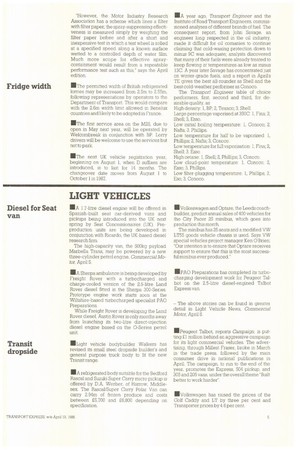MANUFACTURERS
Page 30

Page 31

If you've noticed an error in this article please click here to report it so we can fix it.
• Scania continues to be one of Europe's few profitable truck manufacturers. Truck and bus sales last year were up eight per cent at 25,810 (90 per cent exported). It has begun selling trucks in the United States. Pretax income last year including sales of Volkswagen/Audi cars in Sweden, amounted to £171 million, IIRenault Vehicules Industriels lost FFr 1.96bn (£161 million) in 1985 better than its £257 million loss in '84. RVI was the third biggest manufacturer in Western Europe last year behind Daimler-Benz and Iveco. RVI produced 40,000 commercial vehicles, at a loss per vehicle which has dropped from £7,000 to £4,025, ▪ Drive-axle air suspension designed and built by Terberg Benschop will soon become a factory fitted option for Leyland Roadtrain tractive units. No price has been fixed, but in France, where it was developed for Renaults, it costs between £2,000 and £2,700.
liMidland Tankers, the road tanker division of Hartford Motors (Oxford) has converted a Ford Cargo for bottom loading and vapour recovery.
MAndover Trailers has a new range of drop-frame low-loaders with trailer gross weights from 36 to 80 tonnes. Tri-axle air suspension provides for good axle load equalisation, minimising tyre wear. A choice of running gear includes BPW or Granning air suspension with Rubery Owen-Rockwell axles, In Man has introduced a lighter alternative to its 16.240 drawbar chassis. It is the 16.192 plated at 31.3 tonnes GTW and derived from the 16.170 chassis, It uses the same 5.68-litre turbocharged and intercooled six-cylinder engine but with more power obtained from changed injection pump.
In Paden is about to incorporate noise suppression modifications, developed on its QHV90 (Quite Heavy Vehicle for the Nineties) project vehicle, on production models.
II Daimler-Benz may introduce a pickup model of its G-Series 4x4 into Britain. This would be part of its revised marketing strategy following financial setbacks and the collapse of predicted high-volume Third World markets.
111Steyr-Daimler-Puch's new range of nine to 16-tonne chassis, fitted with aerodynamic cab and more efficient engines, may be introduced to the UK eventually.
MPerkins is developing a new range of engine the Phaser, four-stroke, liquid in-line diesels of four or six cylinders, They are designed for vehicles grossing between six adn 24 tonnes. More than £30 million is being invested.
111Frank Guy of Clay Cross, Derbyshire, is offering its own sleeper and crew-cab conversions for the Volvo FL6 and FL7, at £1,450 and £2,445 respectively. "However, the Motor Industry Research Association has a scheme which lines a filter with filter paper; the spray-suppressing effectiveness is measured simply by weighing the filter paper before and after a short and inexpensive test in which a test wheel is rolled at a specified speed along a known surface wetted to a controlled depth of water film. Much more scope for effective spraycontainment would result from a repeatable performance test such as this," says the April edition E The permitted width of British refrigerated lorries may be increased from 2.5m to 2.55m, following representations by operators to the Department of Transport. This would compare with the 2.6m width limit allowed in Benelux countries and likely to be adopted in France.
E The first service area on the M25, due to open in May next year, will be operated by Welcombreak in conjunction with BP. Lorry drivers will be welcome to use the services but not to park, • The next UK vehicle registration year, beginning on August 1, when D suffixes are introduced, is to last for 14 months. The changeover date moves from August 1 to October 1 in 1987.
• A year ago, Transport Engineer and the Institute of Road Transport Engineers, commissioned analyses of different brands of fuel. The consequent report, from John Savage, an engineer long respected in the oil industry. made it difficult for oil cornanies to continue claiming that cold-waxing protection down to minus 9C was adequate; analysts discovered that many of their fuels were already treated to keep flowing at temperatures as low as minus 13C. A year later Savage has concentrated just on winter-grade fuels, and a report in April's TE gives the best all-rounder as Shell and the best cold-weather performer as Conoco.
The Transport Engineer table of choice performers, first, second and third, for desirable quality, as
High density: 1, BP; 2, Texaco; 3, Shell.
Large percentage vaporised at 350C: I , Fina; 2, Shell; 3, Esse.
Low initial boiling temperature, 1, Conoco; 2, Nafta; 3, Phillips.
Low temperature for half to be vaporised: 1, Phillips; 2, Nafta; 3, Conoco, Low temperature for full vaporisation: 1, Fins; 2, Shell; 3, Esso.
High cetane. 1, Shell; 2, Phillips; 3, Conoco, Low cloud-point temperature: 1, Conoco, 2, Esso; 3, Phillips.
Low filter-plugging temperature, 1, Phillips; 2, Eso; 3, Conoco.






























































